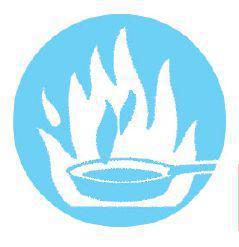SAS Urban Survival Handbook (21 page)
Read SAS Urban Survival Handbook Online
Authors: John Wiseman
Tags: #Health & Fitness, #Reference, #Survival, #Fiction, #Safety, #Self-Help, #Personal & Practical Guides, #General, #Survival Skills
Always check that the time you have set reads accurately on the timer digital display. It is particularly easy to mis-key touchpad controls. Adding an extra digit could have serious repercussions.
Set to the minimum cooking time—you can always reset for a little longer but you can’t uncook a burned-up plateful.
Clean the oven carefully after use, following the maker’s instructions. Spillages which are recooked can easily overheat and burst into flame
Gas cookers
Older-style, self-igniting gas rings using a pilot light make siting of a gas cooker particularly important. If the pilot jet blows out, the kitchen could fill with gas. ALWAYS check to see that a ring has lit—and stayed alight.
If matches are used to light the cooker, do NOT leave them on the top of the stove. They could all catch fire—or fall down beside the cooker and ignite there later.
Match the pot to the size of the ring and do not turn flames high enough to reach up the sides of pans.
Always close oven doors gently. A slam could create a draught of air which blows out the gas jets if they are turned low by the thermostat.
Fat fires
A commonly-occurring cooking hazard—a pan of hot fat catches alight. This can happen with both shallow and deep frying. Use a pan with a lid—and keep the lid close by so that you can replace it, cutting off the oxygen supply to the flames and extinguishing the fire. If you have a fire-blanket—a must for every kitchen—approach with the blanket raised to protect your face, and smother the flames. If you have no lid or blanket use a chopping board or damp towel. Don’t forget to turn off the heat source. Don’t move the pan until the fat cools.
Keep careful control of fat temperature and level and do not place wet food into the fat. Dry it first on kitchen paper. Wet food may make fat spit and increase the risk of igniting. Watch out how much fat you use in a pan—as soon as food is added, the level will rise. This is because of the volume of the food itself and the bubbling action of the fat as it is added. Most fires start at this point during cooking.
Automatic deep fryers with a thermostat to prevent overheating avoid the need to monitor the frying so closely—but do not stand the fryer immediately in front of the socket into which it is plugged. A fire is unlikely unless the control breaks down, but you need to be able to switch it off easily. When you open the lid, watch out for a cloud of steam!
Automatic fryer or not, a large volume of hot oil can take a couple of hours to cool down!

EMERGENCY!
FAT FIRE
- ►
TURN OFF THE HEAT
IF YOU HAVE A LID FOR THE PAN
Replace it immediately to smother the flames
IF YOU HAVE A FIRE BLANKET
Approach with the blanket held up to protect your face and smother the flames
IF YOU HAVE NO LID OR BLANKET
Cover the pan with a damp towel or chopping board
DO NOT
Move the pan until the fat has cooled
REMEMBER
Low cooker extractor hoods may draw flames up into them. Smother the flames around the pan first. Then switch off the extractor and aim a dry extinguisher into it.
Refrigerators/freezers
Refrigerators have made life much safer by enabling us to keep perishable foods in good condition, at least for short periods. Freezers give the convenience of being able to prepare meals far in advance and to take advantage of seasonal price differences. However, they must be kept clean, free of ice build-up and at the correct temperatures if they are to do their job efficiently and safely.
When defrosting fridges, put the contents into a coolbox or an insulated pack—the kind used for bringing frozen food back from the frozen-food store. When defrosting the freezer, you may be able to transfer some of the contents to the frozen food compartment of a fridge—otherwise use the insulated bags again. If they are not available, wrap frozen items in layers of newspaper.
Do not allow frozen food to thaw (or even partially thaw) and then refreeze. Depending on the type of food, this can be dangerous.
Fridges and freezers usually have a thermostat with a numbered scale, but it cannot give you an accurate idea of their temperature. A fridge should be kept at 2-5°C (35-40°F), while a freezer should be -18°C (-0.4°F) or colder. Make regular checks by leaving a thermometer in the ‘warmest’ part for at least a couple of hours, then taking a reading. In a fridge put the thermometer in the middle of the top shelf. In an upright freezer place at the top front edge on the side the door opens, or in the top basket of a chest freezer. It is a good idea to leave a thermometer permanently attached in these positions.
REMEMBER
Fridges should be kept at a temperature below 5°C (40°F) if they are to be cold enough to inhibit the growth of bacteria—which will still develop slowly as long as the temperature is above freezing point.

WARNING
Fridges and freezers can be coffins, especially chest freezers with latches which hold the lids tightly closed. It can be impossible to open them from the inside. When defrosting lock the room or garage they are in—a child might not freeze to death but could suffocate, since the air supply would soon be used.
Food processors/mixers
Modern electric food processors, with their rapidly-turning blades, look much more dangerous than the old-fashioned kinds. However, most of them will not work until a safety cover is securely in place and offer no danger in use—provided that you follow all the operating instructions and don’t overload the motor. Old-fashioned mincing machines were more likely to trap the fingers and graters can more easily take a chunk out of them. However, modern blades should be handled with caution, especially when washing them, and still stored out of the reach of children.
Always unplug electrical appliances before wiping or removing parts for washing. NEVER put the motor unit in water. Wipe it with a slightly damp cloth.
Follow the makers’ instructions regarding running time and the type and quantity of food it can process. If the motorcasing becomes hot, switch off and allow it to cool down. If it seems to be getting hot regularly, or smells hot, or if the motor sounds under strain, you may be misusing it in some way, or it may need servicing.
Electric kettles and jugs
ALWAYS unplug before filling. Keep and use the kettle on a firm surface, well away from the edge. Do not leave the flex dangling—or plugged in and switched on, while not connected to the kettle. Live flex hanging over a sink, or even on a surface where liquids could be spilled, could easily make contact with water and short-circuit—at worst cause ELECTROCUTION.
It’s best to shorten the flex, so that there is just enough to comfortably reach the kettle from the socket. Or fit a curly cable instead, to avoid trailing flexes which a child could grab.
Descale the kettle regularly. Scale build-up could affect the automatic cut-out device—or cause overheating.

WARNING
All electrical appliances generate heat in use. Follow manufacturers’ instructions carefully concerning running times and safe ventilation. Fitted-in appliances must have adequate ventilation and insulation to avoid a fire risk.
Toasters
Few people switch off toasters when not in use. You should, to avoid children ‘toasting’ things—like paperback books! Make sure you regularly empty out all crumbs/debris from the toaster. If this accumulates, overheating may occur. NEVER place the toaster so that anything can interfere with the pushdown operating lever.
Tests have shown that some toasters can melt dramatically and burst into flame in these circumstances. Some toasters only stop heating the elements when the lever returns to the ‘up’ position. NEVER fiddle about inside a toaster with a metal utensil. If your toast gets stuck, first switch off and unplug. Then free the toast with a plastic or wooden spatula—but avoid touching the elements.
Washing machines
NEVER leave switched on, especially if the machine is ‘plumbed in’. If it is, ALWAYS turn off the water when the machine is not in use. The water-intake valves could fail under constant pressure of mains water. If the waste pipe is hooked over a sink, ensure water in the sink never covers the end of the pipe. Water could be syphoned back into the machine.
ALWAYS follow manufacturers’ instructions about safe loading and operation. If a violent wobbling takes place during spinning, switch off the machine and try the last part of the programme (final rinse to spin) again to try to redistribute the load. If this doesn’t work, you may have to let the machine ‘empty’ the water (on front loaders) and find a part of the cycle that will allow you to open the door.

WARNING
When washing machines and tumbledryers are not in use, switch OFF. Children have been known to crawl in or put pets in. Several nasty injuries and even deaths have occurred in tumbledryers—where a child has climbed inside and closed the door from the inside, thereby starting the machine.
If you use a lot of bleach in your machine regularly, the rubber seals may begin to degrade a lot sooner.
Using the wrong washing powder (using manual in automatics) can produce violent results, with more foam being produced than you or the machine can handle. The safe operating of the machine may also be affected.
Cupboards and drawers
Some of the simplest mishaps can lead to worse accidents. As you are distracted by a minor misadventure, you are less able to react efficiently to something else. A slip in the kitchen can bring you into contact with flame, hot liquids and sharp implements as well as sharp corners and hard surfaces.